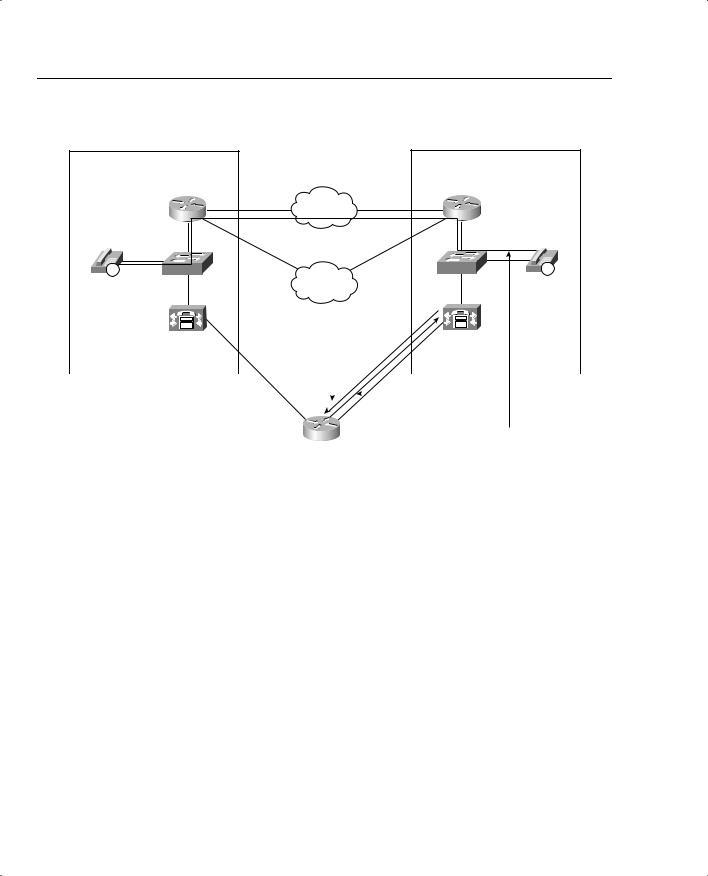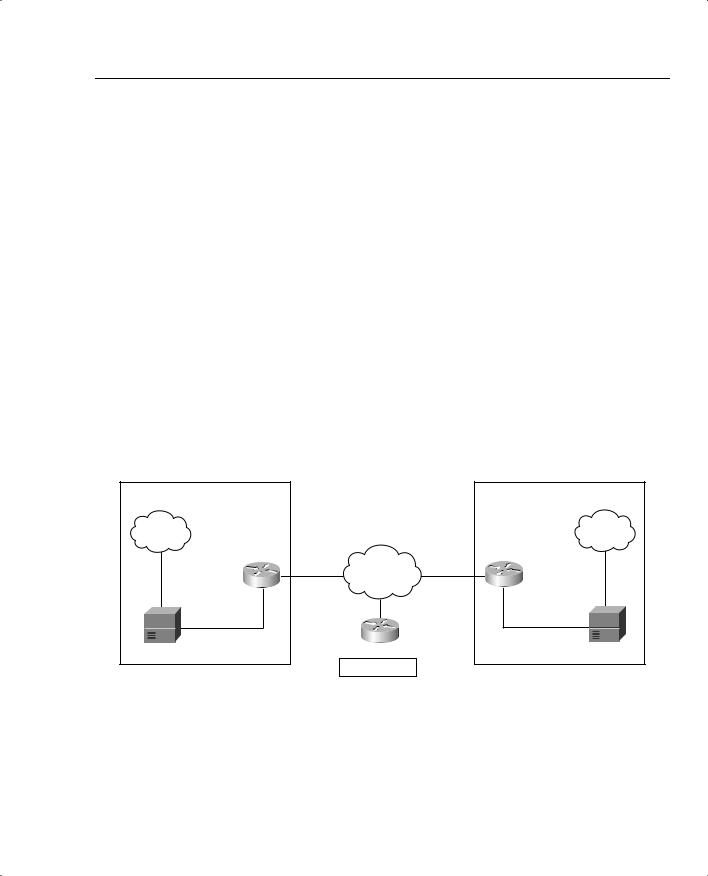
- •QoS Overview
- •“Do I Know This Already?” Quiz
- •QoS: Tuning Bandwidth, Delay, Jitter, and Loss Questions
- •Foundation Topics
- •QoS: Tuning Bandwidth, Delay, Jitter, and Loss
- •Bandwidth
- •The clock rate Command Versus the bandwidth Command
- •QoS Tools That Affect Bandwidth
- •Delay
- •Serialization Delay
- •Propagation Delay
- •Queuing Delay
- •Forwarding Delay
- •Shaping Delay
- •Network Delay
- •Delay Summary
- •QoS Tools That Affect Delay
- •Jitter
- •QoS Tools That Affect Jitter
- •Loss
- •QoS Tools That Affect Loss
- •Summary: QoS Characteristics: Bandwidth, Delay, Jitter, and Loss
- •Voice Basics
- •Voice Bandwidth Considerations
- •Voice Delay Considerations
- •Voice Jitter Considerations
- •Voice Loss Considerations
- •Video Basics
- •Video Bandwidth Considerations
- •Video Delay Considerations
- •Video Jitter Considerations
- •Video Loss Considerations
- •Comparing Voice and Video: Summary
- •IP Data Basics
- •Data Bandwidth Considerations
- •Data Delay Considerations
- •Data Jitter Considerations
- •Data Loss Considerations
- •Comparing Voice, Video, and Data: Summary
- •Foundation Summary
- •QoS Tools and Architectures
- •“Do I Know This Already?” Quiz
- •QoS Tools Questions
- •Differentiated Services Questions
- •Integrated Services Questions
- •Foundation Topics
- •Introduction to IOS QoS Tools
- •Queuing
- •Queuing Tools
- •Shaping and Policing
- •Shaping and Policing Tools
- •Congestion Avoidance
- •Congestion-Avoidance Tools
- •Call Admission Control and RSVP
- •CAC Tools
- •Management Tools
- •Summary
- •The Good-Old Common Sense QoS Model
- •GOCS Flow-Based QoS
- •GOCS Class-Based QoS
- •The Differentiated Services QoS Model
- •DiffServ Per-Hop Behaviors
- •The Class Selector PHB and DSCP Values
- •The Assured Forwarding PHB and DSCP Values
- •The Expedited Forwarding PHB and DSCP Values
- •The Integrated Services QoS Model
- •Foundation Summary
- •“Do I Know This Already?” Quiz Questions
- •CAR, PBR, and CB Marking Questions
- •Foundation Topics
- •Marking
- •IP Header QoS Fields: Precedence and DSCP
- •LAN Class of Service (CoS)
- •Other Marking Fields
- •Summary of Marking Fields
- •Class-Based Marking (CB Marking)
- •Network-Based Application Recognition (NBAR)
- •CB Marking show Commands
- •CB Marking Summary
- •Committed Access Rate (CAR)
- •CAR Marking Summary
- •Policy-Based Routing (PBR)
- •PBR Marking Summary
- •VoIP Dial Peer
- •VoIP Dial-Peer Summary
- •Foundation Summary
- •Congestion Management
- •“Do I Know This Already?” Quiz
- •Queuing Concepts Questions
- •WFQ and IP RTP Priority Questions
- •CBWFQ and LLQ Questions
- •Comparing Queuing Options Questions
- •Foundation Topics
- •Queuing Concepts
- •Output Queues, TX Rings, and TX Queues
- •Queuing on Interfaces Versus Subinterfaces and Virtual Circuits (VCs)
- •Summary of Queuing Concepts
- •Queuing Tools
- •FIFO Queuing
- •Priority Queuing
- •Custom Queuing
- •Weighted Fair Queuing (WFQ)
- •WFQ Scheduler: The Net Effect
- •WFQ Scheduling: The Process
- •WFQ Drop Policy, Number of Queues, and Queue Lengths
- •WFQ Summary
- •Class-Based WFQ (CBWFQ)
- •CBWFQ Summary
- •Low Latency Queuing (LLQ)
- •LLQ with More Than One Priority Queue
- •IP RTP Priority
- •Summary of Queuing Tool Features
- •Foundation Summary
- •Conceptual Questions
- •Priority Queuing and Custom Queuing
- •CBWFQ, LLQ, IP RTP Priority
- •Comparing Queuing Tool Options
- •“Do I Know This Already?” Quiz
- •Shaping and Policing Concepts Questions
- •Policing with CAR and CB Policer Questions
- •Shaping with FRTS, GTS, DTS, and CB Shaping
- •Foundation Topics
- •When and Where to Use Shaping and Policing
- •How Shaping Works
- •Where to Shape: Interfaces, Subinterfaces, and VCs
- •How Policing Works
- •CAR Internals
- •CB Policing Internals
- •Policing, but Not Discarding
- •Foundation Summary
- •Shaping and Policing Concepts
- •“Do I Know This Already?” Quiz
- •Congestion-Avoidance Concepts and RED Questions
- •WRED Questions
- •FRED Questions
- •Foundation Topics
- •TCP and UDP Reactions to Packet Loss
- •Tail Drop, Global Synchronization, and TCP Starvation
- •Random Early Detection (RED)
- •Weighted RED (WRED)
- •How WRED Weights Packets
- •WRED and Queuing
- •WRED Summary
- •Flow-Based WRED (FRED)
- •Foundation Summary
- •Congestion-Avoidance Concepts and Random Early Detection (RED)
- •Weighted RED (WRED)
- •Flow-Based WRED (FRED)
- •“Do I Know This Already?” Quiz
- •Compression Questions
- •Link Fragmentation and Interleave Questions
- •Foundation Topics
- •Payload and Header Compression
- •Payload Compression
- •Header Compression
- •Link Fragmentation and Interleaving
- •Multilink PPP LFI
- •Maximum Serialization Delay and Optimum Fragment Sizes
- •Frame Relay LFI Using FRF.12
- •Choosing Fragment Sizes for Frame Relay
- •Fragmentation with More Than One VC on a Single Access Link
- •FRF.11-C and FRF.12 Comparison
- •Foundation Summary
- •Compression Tools
- •LFI Tools
- •“Do I Know This Already?” Quiz
- •Foundation Topics
- •Call Admission Control Overview
- •Call Rerouting Alternatives
- •Bandwidth Engineering
- •CAC Mechanisms
- •CAC Mechanism Evaluation Criteria
- •Local Voice CAC
- •Physical DS0 Limitation
- •Max-Connections
- •Voice over Frame Relay—Voice Bandwidth
- •Trunk Conditioning
- •Local Voice Busyout
- •Measurement-Based Voice CAC
- •Service Assurance Agents
- •SAA Probes Versus Pings
- •SAA Service
- •Calculated Planning Impairment Factor
- •Advanced Voice Busyout
- •PSTN Fallback
- •SAA Probes Used for PSTN Fallback
- •IP Destination Caching
- •SAA Probe Format
- •PSTN Fallback Scalability
- •PSTN Fallback Summary
- •Resource-Based CAC
- •Resource Availability Indication
- •Gateway Calculation of Resources
- •RAI in Service Provider Networks
- •RAI in Enterprise Networks
- •RAI Operation
- •RAI Platform Support
- •Cisco CallManager Resource-Based CAC
- •Location-Based CAC Operation
- •Locations and Regions
- •Calculation of Resources
- •Automatic Alternate Routing
- •Location-Based CAC Summary
- •Gatekeeper Zone Bandwidth
- •Gatekeeper Zone Bandwidth Operation
- •Single-Zone Topology
- •Multizone Topology
- •Zone-per-Gateway Design
- •Gatekeeper in CallManager Networks
- •Zone Bandwidth Calculation
- •Gatekeeper Zone Bandwidth Summary
- •Integrated Services / Resource Reservation Protocol
- •RSVP Levels of Service
- •RSVP Operation
- •RSVP/H.323 Synchronization
- •Bandwidth per Codec
- •Subnet Bandwidth Management
- •Monitoring and Troubleshooting RSVP
- •RSVP CAC Summary
- •Foundation Summary
- •Call Admission Control Concepts
- •Local-Based CAC
- •Measurement-Based CAC
- •Resources-Based CAC
- •“Do I Know This Already?” Quiz
- •QoS Management Tools Questions
- •QoS Design Questions
- •Foundation Topics
- •QoS Management Tools
- •QoS Device Manager
- •QoS Policy Manager
- •Service Assurance Agent
- •Internetwork Performance Monitor
- •Service Management Solution
- •QoS Management Tool Summary
- •QoS Design for the Cisco QoS Exams
- •Four-Step QoS Design Process
- •Step 1: Determine Customer Priorities/QoS Policy
- •Step 2: Characterize the Network
- •Step 3: Implement the Policy
- •Step 4: Monitor the Network
- •QoS Design Guidelines for Voice and Video
- •Voice and Video: Bandwidth, Delay, Jitter, and Loss Requirements
- •Voice and Video QoS Design Recommendations
- •Foundation Summary
- •QoS Management
- •QoS Design
- •“Do I Know This Already?” Quiz
- •Foundation Topics
- •The Need for QoS on the LAN
- •Layer 2 Queues
- •Drop Thresholds
- •Trust Boundries
- •Cisco Catalyst Switch QoS Features
- •Catalyst 6500 QoS Features
- •Supervisor and Switching Engine
- •Policy Feature Card
- •Ethernet Interfaces
- •QoS Flow on the Catalyst 6500
- •Ingress Queue Scheduling
- •Layer 2 Switching Engine QoS Frame Flow
- •Layer 3 Switching Engine QoS Packet Flow
- •Egress Queue Scheduling
- •Catalyst 6500 QoS Summary
- •Cisco Catalyst 4500/4000 QoS Features
- •Supervisor Engine I and II
- •Supervisor Engine III and IV
- •Cisco Catalyst 3550 QoS Features
- •Cisco Catalyst 3524 QoS Features
- •CoS-to-Egress Queue Mapping for the Catalyst OS Switch
- •Layer-2-to-Layer 3 Mapping
- •Connecting a Catalyst OS Switch to WAN Segments
- •Displaying QoS Settings for the Catalyst OS Switch
- •Enabling QoS for the Catalyst IOS Switch
- •Enabling Priority Queuing for the Catalyst IOS Switch
- •CoS-to-Egress Queue Mapping for the Catalyst IOS Switch
- •Layer 2-to-Layer 3 Mapping
- •Connecting a Catalyst IOS Switch to Distribution Switches or WAN Segments
- •Displaying QoS Settings for the Catalyst IOS Switch
- •Foundation Summary
- •LAN QoS Concepts
- •Catalyst 6500 Series of Switches
- •Catalyst 4500/4000 Series of Switches
- •Catalyst 3550/3524 Series of Switches
- •QoS: Tuning Bandwidth, Delay, Jitter, and Loss
- •QoS Tools
- •Differentiated Services
- •Integrated Services
- •CAR, PBR, and CB Marking
- •Queuing Concepts
- •WFQ and IP RTP Priority
- •CBWFQ and LLQ
- •Comparing Queuing Options
- •Conceptual Questions
- •Priority Queuing and Custom Queuing
- •CBWFQ, LLQ, IP RTP Priority
- •Comparing Queuing Tool Options
- •Shaping and Policing Concepts
- •Policing with CAR and CB Policer
- •Shaping with FRTS, GTS, DTS, and CB Shaping
- •Shaping and Policing Concepts
- •Congestion-Avoidance Concepts and RED
- •WRED
- •FRED
- •Congestion-Avoidance Concepts and Random Early Detection (RED)
- •Weighted RED (WRED)
- •Flow-Based WRED (FRED)
- •Compression
- •Link Fragmentation and Interleave
- •Compression Tools
- •LFI Tools
- •Call Admission Control Concepts
- •Local-Based CAC
- •Measurement-Based CAC
- •Resources-Based CAC
- •QoS Management Tools
- •QoS Design
- •QoS Management
- •QoS Design
- •LAN QoS Concepts
- •Catalyst 6500 Series of Switches
- •Catalyst 4500/4000 Series of Switches
- •Catalyst 3550/3524 Series of Switches
- •Foundation Topics
- •QPPB Route Marking: Step 1
- •QPPB Per-Packet Marking: Step 2
- •QPPB: The Hidden Details
- •QPPB Summary
- •Flow-Based dWFQ
- •ToS-Based dWFQ
- •Distributed QoS Group–Based WFQ
- •Summary: dWFQ Options

Resource-Based CAC 601
In summary, a multizone gatekeeper network offers the following CAC attributes:
•The WAN bandwidth at each connecting site can be protected, provided each site is also a zone. For small remote sites in an enterprise network, this often translates into a zone per gateway, which might not be a practical design.
•The bandwidth within a site can be protected if necessary, but this is frequently of little value because there is only one gateway in the site (small remote offices, or a customer premises equipment [CPE] entry point to an SP-managed network service) or because a high-speed LAN is between the gateways (large sites and SP POPs).
•Gatekeeper CAC is a method well suited to limit the number of calls between sites.
Gatekeeper CAC cannot protect the bandwidth on WAN segments not directly associated with the zones. For example, gatekeeper CAC cannot protect the backbone link marked with 20 calls in the simple enterprise topology shown in Figure 8-24, unless the slowest link approach is followed.
Zone-per-Gateway Design
Because the zone-per-gateway design offers the finest granularity of gatekeeper CAC, it is worth exploring a little further. In enterprise networks, this often makes sense from the following points of view:
•Geographical considerations
•CAC to protect the WAN access link into a site containing a single gateway
•Dialing plans that coincide with sites, allowing a zone prefix to easily translate to the gateway serving a specific site
A gatekeeper is a logical concept, not a physical concept. Each gatekeeper therefore does not imply that there is a separate box in the network; it merely means that there is a separate local zone statement in the configuration.
With Cisco IOS Release 12.1(5)T and Release 12.2, a small remote site router has the capability to provide gateway, gatekeeper, and WAN edge functionality; however, a zone-per-gateway design complicates the scalability aspect that gatekeepers bring to H.323 networks. You should therefore carefully consider the advantages and limitations of such a design.
Gatekeeper in CallManager Networks
Of all the CAC mechanisms discussed in this chapter, gatekeeper zone bandwidth is the only method applicable to multi-site distributed CallManager clusters. In this scenario, the CallManager behaves like a VoIP gateway to the H.323 gatekeeper, as is shown in Figure 8-27.

602 |
Chapter 8: Call Admission Control and QoS Signaling |
|
|
||
Figure 8-27 Gatekeeper in a CallManager Topology |
|
|
|||
|
|
CallManager |
|
CallManager |
|
|
|
Cluster A |
|
|
Cluster B |
|
|
R1 |
IP Network |
R1 |
|
|
|
|
|
||
|
IP |
SW1 |
|
SW1 |
IP |
|
x1111 |
|
PSTN |
|
x2111 |
|
Can I Make a Call? (ARQ) |
||||
CallManager |
|
|
|
|
CallManager |
|
|
|
|
||
Zone 1 |
|
|
|
|
Zone 2 |
|
|
|
|
|
|
|
|
|
|
Yes You Can (ACF) or |
|
|
|
|
|
No You Cannot (ARJ) |
|
Call Is Placed if Allowed
Gatekeeper
In this example, the CallManager in Zone 2 requests the WAN bandwidth to carry a voce conversation from the gatekeeper on behalf of the IP Phone x2111. The gatekeeper determines whether each zone has sufficient bandwidth to establish the call. If the gatekeeper allows the call to proceed, the CallManager in Zone 2 contacts the CallManager in Zone 1 to begin call setup. If the gatekeeper rejects the call, the CallManager in Zone 2 can reroute the call over the PSTN to reach the called party.
Zone Bandwidth Calculation
The gatekeeper does not have any knowledge of network topology and does not know how much bandwidth is available for calls. Nor does the gatekeeper know how much of the configured bandwidth on the links is currently used by other traffic. The gatekeeper takes a fixed amount of bandwidth, statically configured on the gatekeeper, and subtracts a certain amount of bandwidth for each call that is set up. Bandwidth is returned to the pool when a call is disconnected. If a request for a new call causes the remaining bandwidth to become less than zero, the call is denied. The gatekeeper does not use bandwidth reservation. Instead, the gatekeeper performs a static calculation to decide whether a new call should be allowed.
It is the responsibility of the gateways to inform the gatekeeper of how much bandwidth is required for a call. Video gateways therefore could request a different bandwidth for every

Resource-Based CAC 603
call setup. One video session may require 256 kbps, whereas another requires 384 kbps. Voice gateways should consider codec, Layer 2 encapsulation, and compression features, such as compressed Real Time Protocol (cRTP), when requesting bandwidth from the gatekeeper. Sometimes these features are not known at the time of call setup, in which case a bandwidth change request can be issued to the gatekeeper after call setup to adjust the amount of bandwidth used by the call. As of Cisco IOS Software Release 12.2(2)XA, Cisco has implemented only the functionality of reporting any bandwidth changes when the reported codec changes.
Prior to Cisco IOS Software Release 12.2(2)XA on a Cisco H.323 Gateway, calls were always reported to require a bandwidth of 64 kbps. This is the unidirectional payload bandwidth for a Cisco G.711 codec. If the endpoints in the call chose to use a more efficient codec, this was not reported to the Cisco gatekeeper. In the Cisco IOS Software Release 12.2(2)XA version of the Cisco H.323 Gateway or a later version that conforms with H.323 version 3, the reported bandwidth is bidirectional. Initially, 128 kbps is specified. If the endpoints in the call select
a more efficient codec, the Cisco gatekeeper is notified of the bandwidth change.
Figure 8-28 illustrates a network that uses a gatekeeper to limit bandwidth to 144 kbps between two zones. A connection is requested with an initial bandwidth of 128 kbps. After the call has been set up, the endpoints report the change in the bandwidth. Assuming the endpoints are using G.729, 16 kbps is subtracted from the configured maximum of 144 kbps. The 16 kbps represents a bidirectional G.729 payload stream to the gatekeeper.
Figure 8-28 Gatekeeper Bandwidth Calculation
Host Site |
|
Remote Site |
PSTN |
|
PSTN |
Zone 1 |
Frame Relay |
Zone 2 |
|
|
|
T1 PRI |
|
|
PBX |
Gatekeeper |
PBX |
|
Z1-Z2: 144 kbps |
|
In the event that the second call arrives before the endpoint requests the change in bandwidth for the first call, the Cisco gatekeeper rejects the second call, because the total requested bandwidth exceeds the 144 kpbs configured. As call 1 is being set up, for example, the gatekeeper records this call as a 128-kbps call and waits for a codec change before adjusting the recorded bandwidth. At this point, the gatekeeper has subtracted 128 kbps from the configured 144 kbps,

604 Chapter 8: Call Admission Control and QoS Signaling
leaving 16 kbps available. If call 2 requests admission before the codec change is reported in call 1, the gatekeeper does not have enough available bandwidth to allow this 128-kbps call to proceed.
Gatekeeper zone bandwidth remains an inexact science because the gateway may not have full knowledge of the bandwidth required by the call. The following examples describe common situations where the gateway will not have full knowledge of the bandwidth required per call:
•The gateway is attached to an Ethernet segment in a campus network where cRTP does not apply and where the Layer 2 headers are larger than they would be for Frame Relay or Multilink Point-to-Point Protocol (MLP) on the WAN legs.
•A different codec is used in the campus network from the WAN segments, leveraging codec transcoding functionality at the WAN edge.
•In the backbone of the network, ATM is used as the transport technology. In this case, cell padding should be taken into account for bandwidth calculations.
•cRTP may be used at the WAN edge router.
Zone Bandwidth Configuration
As of Cisco IOS Software Release 12.1(5)T and Release 12.2, the following types of zone bandwidth limitations can be configured on the gatekeeper:
•The maximum bandwidth for all H.323 traffic between the local zone and a specified remote zone.
•The maximum bandwidth allowed for a single session in the local zone. This configuration is typically used for video applications, not for voice.
•The maximum bandwidth for all H.323 traffic allowed collectively to all remote zones.
Tables 8-16 and 8-17 list the gatekeeper command and options used to configure gatekeeper zone bandwidth.
Table 8-16 Gatekeeper Bandwidth Command
Command |
Mode and Function |
|
|
bandwidth {interzone | total | session} |
Specifies the gatekeeper zone bandwidth restrictions |
{default | zone zone-name} max- |
|
bandwidth |
|
|
|
bandwidth remote max-bandwidth |
Specifies the total bandwidth for H.323 traffic between |
|
this gatekeeper and any other gatekeeper |
|
|
